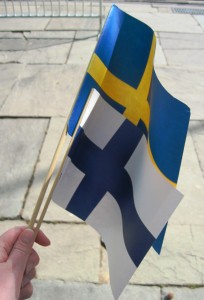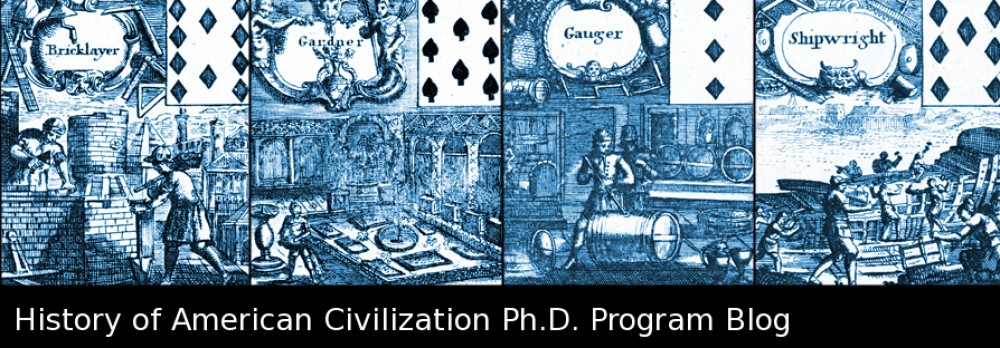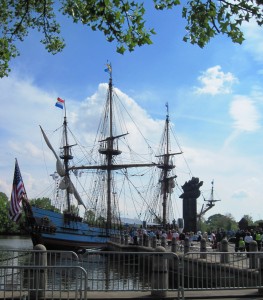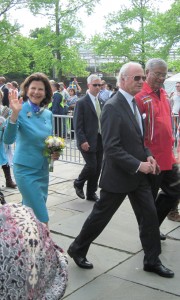Despite its status as the first permanent European settlement in the Delaware Valley, the New Sweden colony does not hold the same place in American mythology as Jamestown or Plymouth—even for people who live quite close to “The Rocks,” the site of the 1638 Swedish landing in what is now Wilmington, Delaware. This is not terribly surprising when you consider the traditional emphasis placed on the English origins of the United States. Moreover, Swedish control of the region was brief; the Dutch conquered the colony in 1655, only seventeen years after the landing.
Yet there are many reminders of the colonial Swedish presence on Delaware’s landscape today. The river on which the Swedes sailed is still called the Christina, after their young queen. The colors of the Swedish flag can be seen throughout the state. A portion of Route 13 in northern Delaware is named Governor Printz Boulevard, after the man who led the colony between 1643 and 1653. In Wilmington you can visit Old Swedes Church, built in 1699, and Fort Christina State Park. A national historic landmark, the park occupies the site of the first fort built by the Swedish colonists and encompasses “The Rocks”. In my dissertation I explore the creation of this memorial landscape for the New Sweden tercentenary in 1938. It was with a sense of déjà vu that I attended the New Sweden Jubilee, the commemoration of the 375th anniversary of the landing of the Swedes, on May 11. Commemorations are somehow both ephemeral and eternal. Although the pageantry is short lived, they follow the same patterns and take place on the same “sacred” ground.
Since parking is a problem in the neighborhood around Fort Christina, I left my car in a lot on Wilmington’s Riverfront and then jumped on a school bus that took us to the park. I ended up waiting for quite a while for the ceremony to begin, and I was thankful that I could sit in the shade while listening to the First State Symphonic Band. Around 3pm the visiting dignitaries, including King Carl XVI Gustaf and Queen Silvia of Sweden and Finland’s Speaker of Parliament Eero Heinaluoma, arrived on the Kalmar Nyckel, the replica of the ship that brought the Swedish and Finnish colonists to the Delaware Valley in 1638. (Finland was under Swedish control at the time of the settlement.)

Each attendee received two flags. Although the commemorators sought to celebrate the Swedish and the Finnish colonists equally, Sweden’s flag was larger. Some of the commemorators of the 300th anniversary in 1938 did not want the Finns involved at all.
The delegation had boarded the ship at the Riverfront after being welcomed by Wilmington Mayor Dennis Williams and Mayor Johan Persson of Wilmington’s Sister City Kalmar, Sweden. The ship docked at Fort Christina State Park, where it was met by representatives of several American Indian groups and Swedish-American heritage organizations, some of whom were in costume. After the official addresses, the Swedish royals placed a wreath to honor the settlers in front of the monument that had been presented to the United States by the people of Sweden for the tercentenary. Attendees lined the walkway to cheer the dignitaries as they exited the park and carried on to Old Swedes Church for a special service. The day concluded with a formal Jubilee Gala on the Riverfront, attended by Vice President Joe Biden and other leading Delawareans. It must have been a long day for the members of the official delegation, who also attended a symposium entitled “Making it in America” at Philadelphia’s Independence Seaport Museum in the morning, followed by a trip to Chester, PA to lay a wreath at the Finnish Monument, a gift of the people of Finland to the United States for the 1938 commemoration, and a luncheon with Delaware Governor Jack Markell.
The participants in this Jubilee Landing in many ways retraced the steps of the commemorators of the 300th anniversary of the Swedish landing in 1938. The tercentenary celebration took place on June 27, 1938, a day of steady rainfall. The royal liner Kungsholm docked on the Christina River near the new park. The guest of honor, the Crown Prince of Sweden, remained on the ship because of a kidney attack; his son, Prince Bertil, took his place on the platform with President Franklin Delano Roosevelt and Richard C. McMullen, the governor of Delaware. After a delay of an hour and a half, the dedication of the park and the monument commenced. Military bands played the American and Swedish national anthems and the speakers enthusiastically gave thanks for the heritage of the early settlers. Following the dedication the official delegations from Sweden and Finland gathered for a service in Old Swedes Church. Then there were luncheons at the Delaware State Armory for Swedish tourists and at Hotel Du Pont for official delegates. The afternoon events included an address in Rodney Square by Cordell Hull, U. S. Secretary of State, and a parade of floats depicting the history of Delaware and representing the DuPont Company and other important industrial organizations. Although some highways were flooded, an estimated 10,000 to 15,000 people entered the city by automobile, 5,000 by rail, and 1,500 by bus to attend the festivities. The celebration concluded with a party for the official delegates and invited guests at Longwood, the estate of philanthropist and businessman Pierre S. du Pont. Following the Wilmington celebration, the Royal Swedish party traveled to Philadelphia and Chester, Pennsylvania, and to Swedesboro and Salem, New Jersey, to attend ceremonies commemorating settlements in those areas of the Delaware Valley.
The similarities between 1938 and 2013 did not end with the location and program of the commemoration. Speakers on both occasions emphasized the introduction of the log cabin and peaceful relations with the Lenni Lenape as part of the Swedish legacy. There was even the same trace of defensiveness when it came to New Sweden’s importance in relation to the more celebrated English colonies. (One speaker declared that “The Rocks,” which formed a natural rock wharf for the colonists, “are much more important than Plymouth Rock, which was just a boulder that a few people stepped on.”)

Despite the beautiful weather and the opportunity to see royalty, Fort Christina State Park was largely empty.
Unlike the tercentenary, however, the New Sweden Jubilee did not seem to involve as many Delawareans. The New Sweden Alliance, the nonprofit organization that orchestrated the commemoration, is an umbrella organization of Swedish- and Finnish-American heritage groups in Delaware, Pennsylvania, and New Jersey. Although such groups participated in the tercentenary, the main celebration in 1938 fell under the control of a state commission, sponsored by state and federal funding. Perhaps this accounts for the general lack of awareness about the event among Delawareans and the low attendance at the ceremony. According to the Wilmington News Journal, 1,000 people attended the ceremony, which is only about a quarter of the park’s capacity.
If you are interested in learning more about New Sweden, visit the Delaware Historical Society’s exhibit at the Willingtown Square Gallery in Wilmington. Or come to the University of Delaware in November for the 375th Anniversary New Sweden Conference, entitled “Encountering ‘Others’ in the Atlantic World: Perspectives from the Material World.”
Anne Reilly is interested in the material culture of memory and the relationship between public commemorations and national identity. Her dissertation explores the creation of memorial landscapes at the sites of the Jamestown, Plymouth, and New Sweden colonies at the time of their tercentenaries in 1907, 1920, and 1938, respectively.



